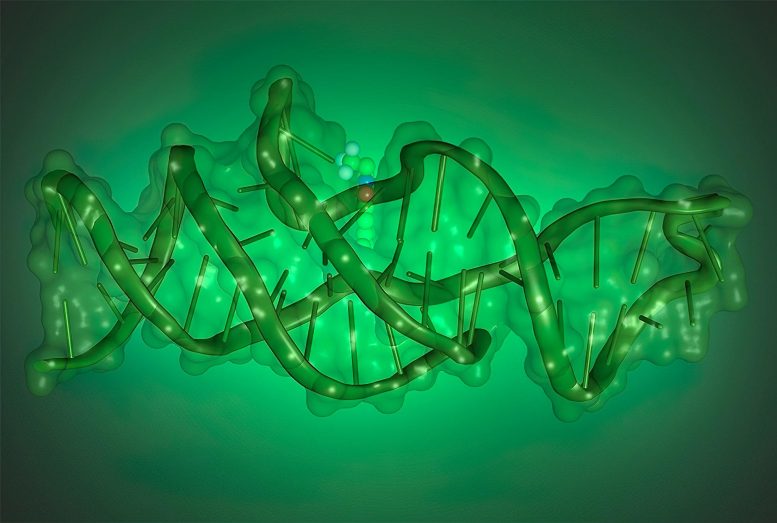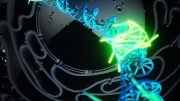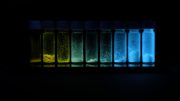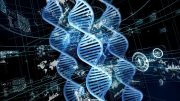
Illustration showing the structure of Lettuce, a DNA that binds and activates fluorophores derived from green fluorescent protein. Credit: Luiz F.M. Passalacqua
In a groundbreaking study, researchers from Weill Cornell Medicine and the National Heart, Lung, and Blood Institute, a department of the National Institutes of Health, found that DNA can emulate the functions of proteins by forming intricate, three-dimensional structures.
This research, which was recently published in the journal Nature, made use of high-definition imaging technologies to uncover the unique and multifaceted configuration of a synthesized DNA molecule. This molecule was designed to simulate the behavior of a protein known as green fluorescent protein (GFP). Originally extracted from jellyfish, GFP has become a critical tool in labs, serving as a luminescent marker or beacon within cells.
The findings advance the science of how DNA can be made to fold into complex shapes, and will help researchers build such DNA molecules for a variety of laboratory and clinical applications. An all-DNA fluorescent tag that mimics GFP, for example, would often be ideal for labeling targeted pieces of DNA in biological studies and in diagnostic test kits, and would be relatively inexpensive to make.
“These findings really change our understanding of what we can do with DNA,” said study co-author Dr. Samie Jaffrey, Greenberg-Starr Professor of Pharmacology and a member of the Sandra and Edward Meyer Cancer Center at Weill Cornell Medicine.
DNA in nature exists mostly in a double-stranded, “twisted ladder” or “helical” form, and serves as a relatively stable store of genetic information. All of the other complex biological processes in cells are done by other types of molecules, especially proteins.
Last year, Dr. Jaffrey and colleagues reported discovering one such molecule: a single-stranded DNA that folds in a way that allows it to mimic the activity of GFP. The DNA molecule, which Dr. Jaffrey dubbed “lettuce” for the color of its fluorescent emissions, works by binding to another small organic molecule, a potentially fluorescent “fluorophore” similar to the one at the heart of GFP, and squeezing it in a way that activates its ability to fluoresce. The researchers demonstrated the lettuce-fluorophore combination as a fluorescent tag for the rapid detection of SARS-CoV-2, the cause of COVID-19.
Dr. Jaffrey and his team discovered lettuce by making many single-stranded DNAs and screening for those with the desired fluorophore-activating ability. But they didn’t know what structure lettuce used to acquire this ability. To determine that structure, they turned—in the new study—to their long-time collaborator, NHLBI senior investigator Dr. Adrian R. Ferré-D’Amaré.
In the research led by Dr. Luiz Passalacqua, a research fellow at Dr. Ferré-D’Amaré’s team, advanced structural imaging techniques were used, including cryo-electron microscopy, to resolve the structure of lettuce at atomic-scale resolution. They found that it folds into a shape that has at its center a four-way junction of DNA, of a type never seen before, enclosing the fluorophore in a way that activates it.
They also observed that lettuce’s foldings are held together with bonds between nucleobases—the building blocks of DNA that are often referred to as the “letters” in the four-letter DNA alphabet.
“What we have discovered is not DNA trying to be like a protein; it’s a DNA that is doing what GFP does but in its own special way,” said Dr. Ferré-D’Amaré.
The researchers said that the findings should speed the development of fluorescent DNA molecules such as lettuce for rapid-diagnostic tests as well as a host of other scientific applications in which a DNA-based fluorescent tag is desirable.
“Studies like this are going to be essential for the creation of new DNA-based tools,” Dr. Jaffrey said.
References: “Intricate 3D architecture of a DNA mimic of GFP” by Luiz F. M. Passalacqua, Michael T. Banco, Jared D. Moon, Xing Li, Samie R. Jaffrey and Adrian R. Ferré-D’Amaré, 21 June 2023, Nature.
DOI: 10.1038/s41586-023-06229-8
“Detection of SARS-CoV-2 RNA Using a DNA Aptamer Mimic of Green Fluorescent Protein” by Bria S. VarnBuhler, Jared Moon, Sourav Kumar Dey, Jiahui Wu and Samie R. Jaffrey, 26 March 2023, ACS Chemical Biology.
DOI: 10.1021/acschembio.1c00893









Are there any instructional modules to understand ELISA better?
Each day passing, secrets are being unveiled, disclosed. Adding to knowledge , wisdom . Broadening spectrum of vision.defined by creator thousands of years back that you only need to open your eyes to see the hands of god.Almighty will reveal to you within your own creation and all that exists around you to prove HIS identity .